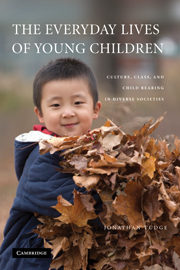Book contents
- Frontmatter
- Contents
- Preface
- Acknowledgments
- 1 Introduction and Stage Setting
- 2 The Daily Lives of Toddlers
- 3 Cultural–Ecological Theory and Its Implications for Research
- 4 Methods
- 5 Life in the Cities
- 6 Everyday Activities
- 7 Settings and Partners
- 8 Everyday Lives
- 9 The Cultural Ecology of Young Children
- References
- Index
- Frontmatter
- Contents
- Preface
- Acknowledgments
- 1 Introduction and Stage Setting
- 2 The Daily Lives of Toddlers
- 3 Cultural–Ecological Theory and Its Implications for Research
- 4 Methods
- 5 Life in the Cities
- 6 Everyday Activities
- 7 Settings and Partners
- 8 Everyday Lives
- 9 The Cultural Ecology of Young Children
- References
- Index
Summary
Our deeds determine us, as much as we determine our deeds.
George Eliot, Adam Bede, 1859/1981, p. 359Over the course of Chapters 3 and 4, I discussed the nature of cultural–ecological theory and the associated methods that my colleagues and I used to collect our data on young children's everyday activities. The goal of this chapter is to describe the main activities in which the children were involved (play, lessons, conversation, and work), describing various types of each of these activities, how they varied both across the different cities and by social class within each city, and race and class in the case of Greensboro. It will also become apparent that at least some of the variation in the extent to which the children were involved in activities can only be explained by individual differences among the children themselves; in each group, some of the children were far more involved in certain of the activities than were others. In part, as I'll show, this can be explained by the children taking a more or less active lead in starting particular activities.
FOCAL AND NONFOCAL ACTIVITIES
As I pointed out in Chapter 4, we distinguished between the activities on which we wanted to focus our attention (focal activities) and those that were less important to us, and which we termed “nonfocal activities.” In all societies children spend a good part of the time in these nonfocal activities, sleeping, eating, being cared for, and so on.
- Type
- Chapter
- Information
- The Everyday Lives of Young ChildrenCulture, Class, and Child Rearing in Diverse Societies, pp. 141 - 184Publisher: Cambridge University PressPrint publication year: 2008

